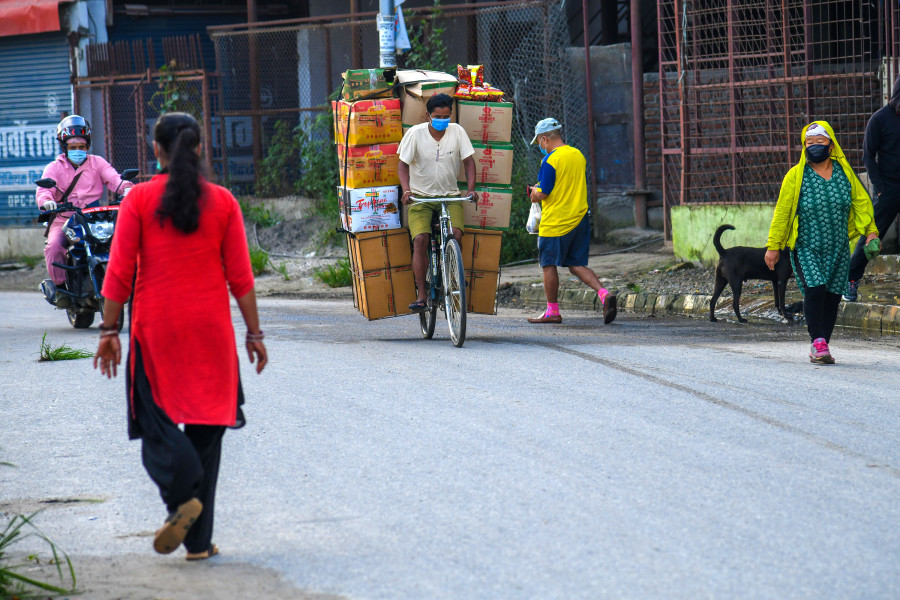Valley
Curbs extended with some relaxations, but experts question ad-hoc moves
Doctors say Valley authorities have failed to make it clear on what basis they are taking decisions, as restrictions for the past three weeks have largely been ineffective and Covid-19 cases have continued to soar.
Tika R Pradhan & Arjun Poudel
Authorities are yet to figure out a way to deal with the coronavirus spread and they are still taking decisions on an ad-hoc basis without holding serious consultations, public health experts said on Wednesday, as restrictions were extended in Kathmandu Valley until September 17.
Chief district officers of the Valley–Kathmandu, Lalitpur and Bhaktapur–on Wednesday evening decided to continue prohibitory orders for another one week, with some relaxations and vehicular movements.
On what basis the decisions are being taken is not known, say public health experts, as the restrictions for the past three week have been largely ineffective in controlling the virus spread. What safety measures and how strictly health protocols are enforced will be a key in the coming days, according to them.
“The spread has continued at an alarming rate since the lockdown was lifted,” said Dr Sher Bahadur Pun, chief of the Clinical Research Unit at Sukraraj Tropical and Infectious Disease Hospital. “Ongoing prohibitory orders have failed to stop the infection rates. The number of cases could rise in the coming days if we fail to enforce safety measures.”
On Wednesday, 464 new cases were reported in three districts of the Valley–394 in Kathmandu, 34 in Lalitpur and 36 in Bhaktapur. So far, 9,440 cases have been reported in the Valley, among which 6,942 were infected since the prohibitory orders were put in place on August 19 midnight.
According to officials, shops will be allowed to open on alternate days while public vehicles will be allowed to operate under the odd-even rules.
Only large public vehicles with more than 16-passenger capacity will be allowed to ply with only half of its passenger’s capacity, according to the order issued by the district administration offices. Taxis will be allowed to operate but only with two passengers a trip.
Shopping malls, clothing stores and cosmetic shops will remain open on Mondays, Wednesdays and Saturdays while utensil stores and those selling kitchen items will be allowed to do businesses on Sundays, Tuesdays and Fridays.
Automobile and furniture shops can open on Mondays and Wednesdays only.
The authorities have also fixed timing for opening shops and services. Malls, footpath shops, pushcarts, stationery stores, department stores and electronics shops can open till 11am in the morning and 4pm to 7pm in the evening. Automobile servicing centers will be allowed to open from 8am to 8pm.
Cafes and restaurants will be allowed to provide take-away services only and online delivery services can operate from 12pm-7pm.
There will be no restrictions on pharmacies, services related to medical equipment and other essentials services.
Shops selling food items and daily essentials can remain open till 11am in the morning and from five to seven in the evening.
Educational institutions, religious and cultural places, crowded industries, factories and businesses, cinema halls, party palaces, beauty parlours, hair salons, gyms, swimming pools, libraries, zoos, museums will remain closed.
The authorities have also continued the ban on seminars and workshops.
“We decided to continue the prohibitory orders for one week after holding discussions with the various stakeholders and taking feedback from them,” said Janak Raj Dahal, chief district officer of Kathmandu.
The Oli administration has been under fire for letting the bureaucrats take decisions on measures to contain the virus spread.
Public health experts say empowering the bureaucrats and ignoring people with expertise to make plans on ways to deal with the pandemic could cost dearly.
The federal government, which faced massive criticism for its ill-thought-out plan to impose the lockdown on March 24 and then lift it on July 21, seems to be passing the buck by asking chief district officers to take decisions on its behalf, experts say.
“The authorities are investing little time on planning and preparing,” said Dr Baburam Marasini, former director at the Epidemiology and Disease Control Division. “Controlling the spread of the virus highly depends on how authorities are doing preparations.”
Of the total number of new cases being detected every day, over 4o percent are being reported from Kathmandu Valley.
“We all know that the risk increases with increased public movements,” Marasini told the Post. “But the authorities are refusing to recognise possible challenges.”
Experts are wondering what exactly the authorities did in terms of preparations for the last three weeks.
The prohibitory orders in the Valley were first imposed starting August 19 midnight for a week. But citing the continuous rise in the coronavirus cases, the restrictions were extended. The current prohibitory orders were to expire on Wednesday midnight. The authorities took a decision just hours before the prohibitory orders ended.
“Are authorities prepared to handle the possible rise in the number of cases?” said Marasini. “People’s movements from areas where more cases have been reported should be stopped. The number of tests need to be increased and contact tracing must be made more effective.”




 7.12°C Kathmandu
7.12°C Kathmandu










%20(1).jpg&w=300&height=200)

